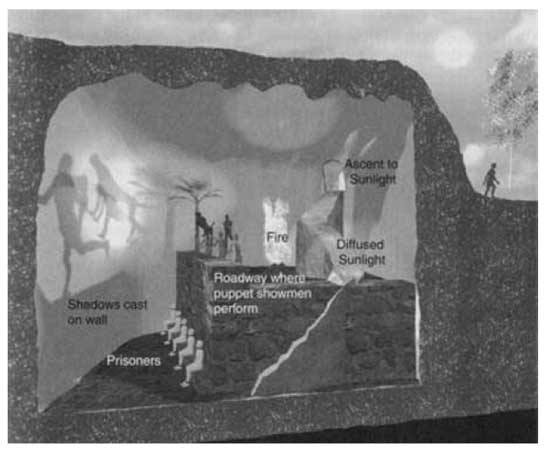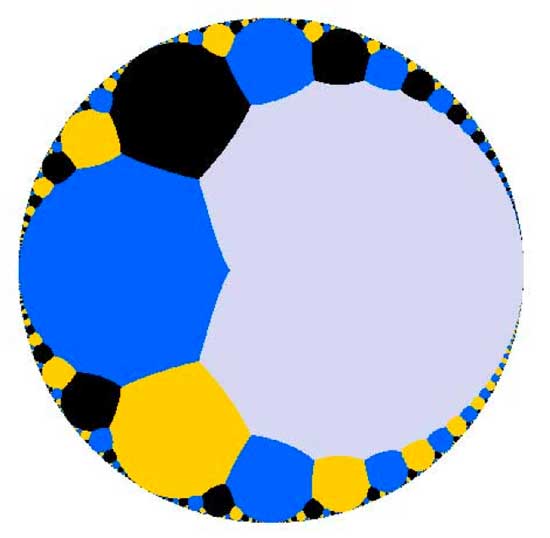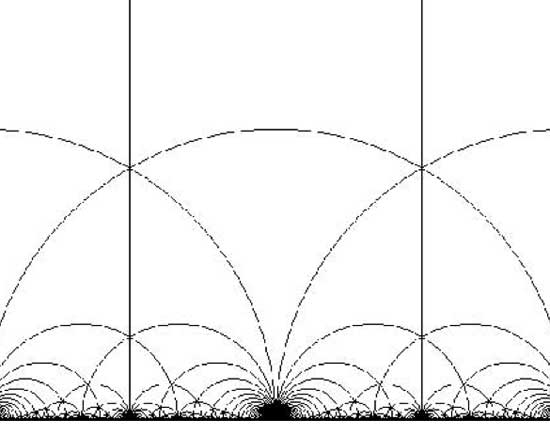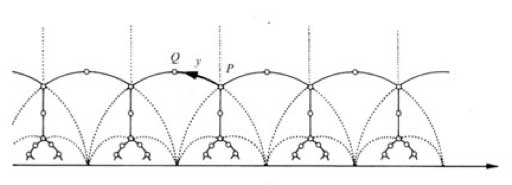Here pdf-files of older NeverEndingBooks-posts on geometry. For more recent posts go here.
Leave a CommentTag: differential
Yesterday, Yuri Manin and Matilde Marcolli arXived their paper
Modular shadows and the Levy-Mellin infinity-adic transform which is a
follow-up of their previous paper Continued fractions, modular symbols, and non-commutative geometry.
They motivate the title of the recent paper by :
In
[MaMar2](http://www.arxiv.org/abs/hep-th/0201036), these and similar
results were put in connection with the so called “holography”
principle in modern theoretical physics. According to this principle,
quantum field theory on a space may be faithfully reflected by an
appropriate theory on the boundary of this space. When this boundary,
rather than the interior, is interpreted as our observable
space‚Äìtime, one can proclaim that the ancient Plato’s cave metaphor
is resuscitated in this sophisticated guise. This metaphor motivated
the title of the present paper.
Here’s a layout of
Plato’s cave

Imagine prisoners, who have been chained since childhood deep inside an
cave: not only are their limbs immobilized by the chains; their heads
are chained as well, so that their gaze is fixed on a wall.
Behind
the prisoners is an enormous fire, and between the fire and the
prisoners is a raised walkway, along which statues of various animals,
plants, and other things are carried by people. The statues cast shadows
on the wall, and the prisoners watch these shadows. When one of the
statue-carriers speaks, an echo against the wall causes the prisoners to
believe that the words come from the shadows.
The prisoners
engage in what appears to us to be a game: naming the shapes as they
come by. This, however, is the only reality that they know, even though
they are seeing merely shadows of images. They are thus conditioned to
judge the quality of one another by their skill in quickly naming the
shapes and dislike those who begin to play poorly.
Suppose a
prisoner is released and compelled to stand up and turn around. At that
moment his eyes will be blinded by the firelight, and the shapes passing
will appear less real than their shadows.
Right, now how
does the Manin-Marcolli cave look? My best guess is : like this
picture, taken from Curt McMullen’s Gallery

Imagine
this as the top view of a spherical cave. M&M are imprisoned in the
cave, their heads chained preventing them from looking up and see the
ceiling (where $PSL_2(\mathbb{Z}) $ (or a cofinite subgroup of
it) is acting on the upper-half plane via
Moebius-transformations ). All they can see is the circular exit of the
cave. They want to understand the complex picture going on over their
heads from the only things they can observe, that is the action of
(subgroups of) the modular group on the cave-exit
$\mathbb{P}^1(\mathbb{R}) $. Now, the part of it consisting
of orbits of cusps
$\mathbb{P}^1(\mathbb{Q}) $ has a nice algebraic geometric
description, but orbits of irrational points cannot be handled by
algebraic geometry as the action of $PSL_2(\mathbb{Z}) $ is
highly non-discrete as illustrated by another picture from McMullen’s
gallery

depicting the ill behaved topology of the action on the bottom real
axis. Still, noncommutative _differential_ geometry is pretty good at
handling such ill behaved quotient spaces and it turns out that as a
noncommutative space, this quotient
$\mathbb{P}^1(\mathbb{R})/PSL_2(\mathbb{Z}) $ is rich enough
to recover many important aspects of the classical theory of modular
curves. Hence, they reverse the usual NCG-picture of interpreting
commutative objects as shadows of noncommutative ones. They study the
_noncommutative shadow_
$\mathbb{P}^1(\mathbb{R})/PSL_2(\mathbb{Z}) $ of a classical
commutative object, the quotient of the action of the modular group (or
a cofinite subgroup of it) on the upper half-plane.
In our
noncommutative geometry course we have already
seen this noncommutative shadow in action (though at a very basic
level). Remember that we first described the group-structure of the
modular group $PSL_2(\mathbb{Z}) = C_2 \ast C_3 $ via the
classical method of groups acting on trees. In particular, we
considered the tree

and
calculated the stabilizers of the end points of its fundamental domain
(the thick circular edge). But
later we were able to give a
much shorter proof (due to Roger Alperin) by looking only at the action
of $PSL_2(\mathbb{Z}) $ on the irrational real numbers (the
noncommutative shadow). Needless to say that the results obtained by
Manin and Marcolli from staring at their noncommutative shadow are a lot
more intriguing…
At
last, some excitement about noncommutative geometry in the blogosphere.
From what I deduce from reading the first posts, Arup Pal set up a new blog
called Noncommutative
Geometry and subsequently handed it over to Masoud Khalkhali who then
got Alain Connes to post on it who, in turn, is asking people to submit
posts, such as todays post by David Goss.
Somehow, most people refer to the Noncommutative Geometry blog as
“Alain Connes’ blog” (for example Doctor Gero, Not Even
Wrong, the n-category cafe and
possibly many others).
David Corfield over at the n-category cafe stops
short of suggesting to rename (by analogy) NeverEndingBooks into
Kontsevich’s blog
A new blog Noncommutative Geometry
has begun, which appears to be of the Connesian variety. (Connes himself
has already commented there.) We mentioned a couple of weeks ago that
there are different flavours of noncommutative geometry. The
Kontsevichian variety, nongeometry, finds its blog voice in Lieven Le
Bruyn’s NeverEndingBooks. It would be interesting to see some
interaction.
I don’t think I will opt for a dialectic
response to the Noncommutative Geometry Blog, although I realize this would result
in more enjoyable reading for some of you…
For starters,
I’ve signed up to another flagship of noncommutative
_differential_ geometry : noncommutativegeometry.net, though it is unclear to me what action (if any) is
going on over there.
Further, I plan to move my talks at the master class
noncommutative geometry to the virtual lecture room of this blog,
hoping to get the desired interaction. We’ll start later this week and
the pace will be pretty easy going. A tentative title might be
“Anabelian versus Noncommutative Geometry”.